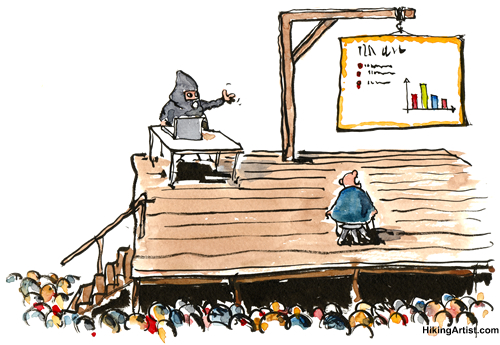Death to PowerPoint (And Why It Will Live)

(Artist: Frits Ahlefeldt-Laurvig/Flickr//CC BY-ND 2.0)
Do you really believe that watching a lecturer read hundreds of PowerPoint slides is making you smarter?
I asked this of a class of 105 computer science and software engineering students last semester.
A recent article argued universities should ban PowerPoint because it makes students stupid and professors boring. I agree entirely. However, most universities will ignore this good advice because rather than measuring success by how much their students learn, universities measure success with student satisfaction surveys, among other things.

This article by Paul Ralph originally appeared at The Conversation, a Social Science Space partner site, under the title “Why universities should get rid of PowerPoint and why they won’t”
What is so wrong with PowerPoint?
Over-reliance on slides has contributed to the absurd belief that expecting and requiring students to read books, attend classes, take notes and do homework is unreasonable.
Courses designed around slides therefore propagate the myth that students can become skilled and knowledgeable without working through dozens of books, hundreds of articles and thousands of problems.
A review of research on PowerPoint found that while students liked PowerPoint better than overhead transparencies, PowerPoint did not increase learning or grades. Liking something doesn’t make it effective, and there’s nothing to suggest transparencies are especially effective learning tools either.
Research comparing teaching based on slides against other methods such as problem-based learning – where students develop knowledge and skills by confronting realistic, challenging problems – predominantly supports alternative methods.
PowerPoint slides are toxic to education for three main reasons:
- Slides discourage complex thinking. Slides encourage instructors to present complex topics using bullet points, slogans, abstract figures and oversimplified tables with minimal evidence. They discourage deep analysis of complex, ambiguous situations because it is nearly impossible to present a complex, ambiguous situation on a slide. This gives students the illusion of clarity and understanding.
- Reading evaluations from students has convinced me that when most courses are based on slides, students come to think of a course as a set of slides. Good teachers who present realistic complexity and ambiguity are criticized for being unclear. Teachers who eschew bullet points for graphical slides are criticized for not providing proper notes.
- Slides discourage reasonable expectations. When I used PowerPoint, students expected the slides to contain every detail necessary for projects, tests and assignments. Why would anyone waste time reading a book or going to a class when they can get an A by perusing a slide deck at home in their pajamas?
Measuring the wrong things
If slide shows are so bad, why are they so popular?
Universities measure student satisfaction but they do not measure learning. Since organizations focus on what they measure and students like PowerPoint, it stays, regardless of its educational effectiveness.
Hospitals measure morbidity and mortality. Corporations measure revenue and profit. Governments measure unemployment and gross domestic product. Even this website measures readership, broken down by article and author. But universities don’t measure learning.
Exams, term papers and group projects ostensibly measure knowledge or ability. Learning is the change in knowledge and skills and therefore must be measured over time.
When we do attempt to measure learning, the results are not pretty. US researchers found that a third of American undergraduates demonstrated no significant improvement in learning over their four-year degree programs. They tested students in the beginning, middle and end of their degrees using the Collegiate Learning Assessment, an instrument that tests skills any degree should improve – analytic reasoning, critical thinking, problem solving and writing.
Any university can deploy similar testing to measure student learning. Doing so would facilitate rigorous evaluations of different teaching methods. We would be able to quantify the relationship between PowerPoint use and learning. We would be able to investigate dozens of learning correlates and eventually establish what works and what doesn’t.
Unfortunately, many key drivers of learning appear to reduce student satisfaction and vice versa. As long as universities continue to measure satisfaction but not learning, the downward spiral of lower expectations, less hard work and less learning will continue.![]()




























































































